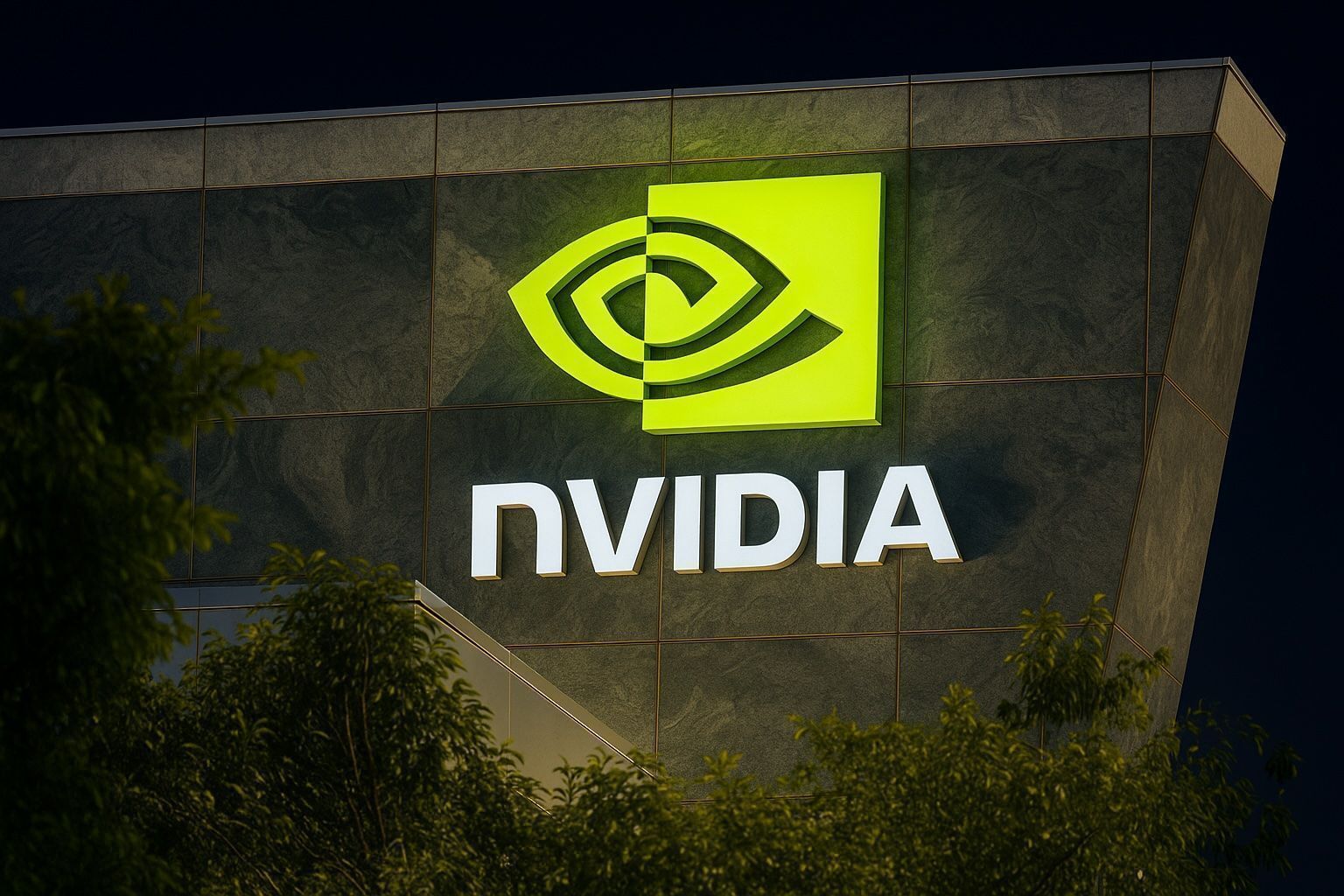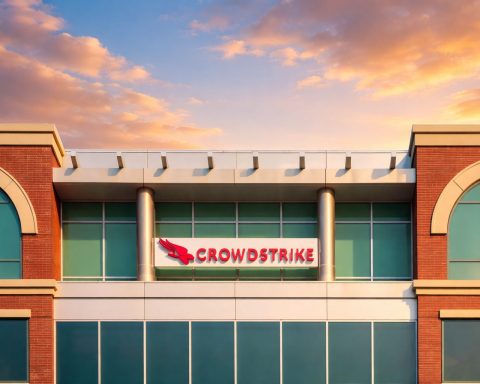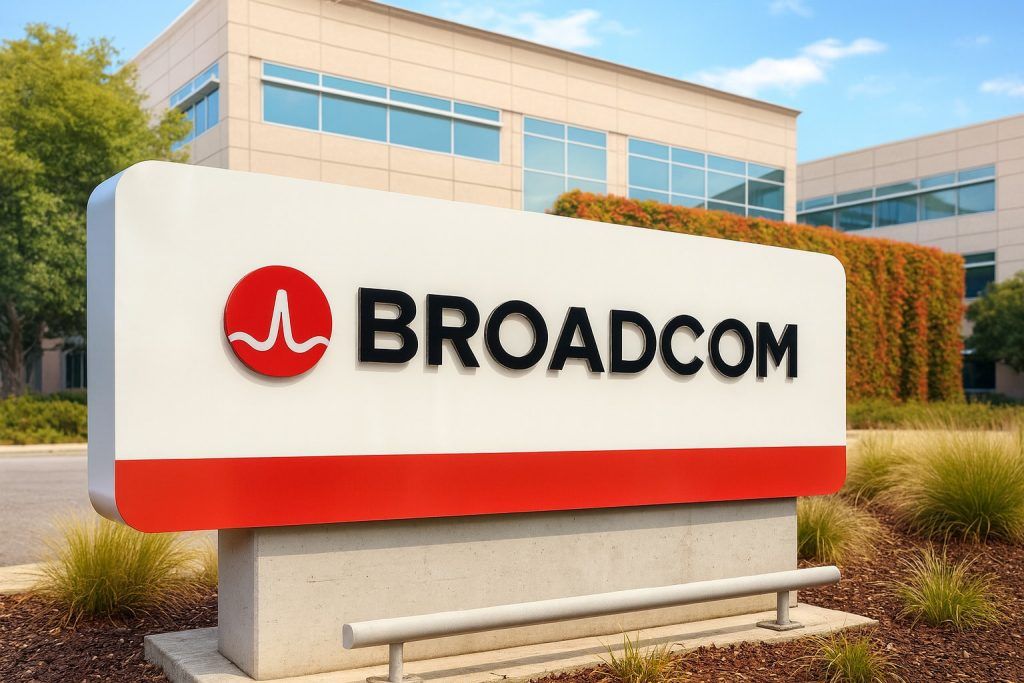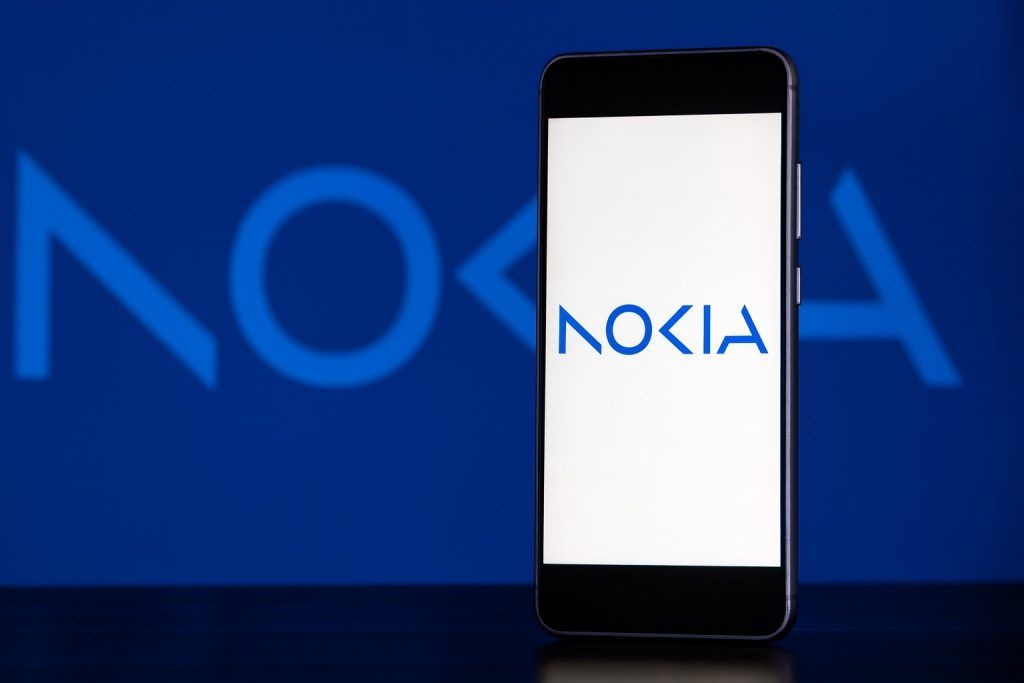Shares of Nvidia (NASDAQ: NVDA) are once again flirting with all-time highs as the AI boom propels massive growth, bold analyst forecasts, and unprecedented tech partnerships. Below we summarize the key developments driving NVDA’s surge and what’s next for the chip titan.
Quick Summary – Key Facts at a Glance:
- NVDA Near Record Highs: Nvidia’s stock is trading around $182 per share as of midday Oct. 24, 2025, within sight of its all-time peak (~$195) hit earlier this month [1]. A mid-October tech pullback briefly knocked NVDA down ~4% in one day (Oct. 14) on profit-taking and rising bond yields [2], but the stock quickly rebounded and remains up ~58% year-on-year [3] – vastly outperforming the broader market.
- AI Boom = Explosive Growth: Insatiable demand for Nvidia’s AI chips fueled a 56% revenue surge last quarter to $46.7 billion [4]. Astonishingly, about 88% of sales ($41 billion) came from data-center GPUs for training generative AI models [5]. This “AI frenzy” has translated into record results, vaulting Nvidia’s market capitalization above $4.4 trillion – briefly making it the world’s most valuable company [6].
- Massive Deals & Investments: Nvidia is doubling down on AI via blockbuster partnerships. It agreed to invest up to $100 billion in OpenAI to provide 10 GW of Nvidia GPU supercomputers for the ChatGPT creator [7]. Last month, Nvidia also took a $5 billion stake in Intel (~4% ownership) as part of a partnership to co-develop advanced chips – a lifeline that sent Intel shares soaring over 20% [8]. And to secure critical capacity, Nvidia joined a consortium acquiring Aligned Data Centers for $40 billion [9], ensuring the infrastructure needed for AI growth.
- Blistering Product Launches: Nvidia’s innovation engine hasn’t slowed. In recent weeks it unveiled the GeForce RTX 50-series GPUs with AI-enhanced gaming features and began shipping DGX Spark, the world’s smallest AI supercomputer for researchers [10]. Nvidia also produced its first U.S.-made “Blackwell” AI chip wafers at TSMC’s new Arizona fab [11] – a milestone in onshore production – and announced plans to build giant next-gen “AI factories” (cutting-edge data centers) to meet exploding demand [12].
- Rivals & Risks Rising: Competition is eyeing Nvidia’s crown. AMD scored a blockbuster deal to supply up to 6 GW of its upcoming MI450 AI chips to OpenAI and won a big order from Oracle’s cloud [13]. While Nvidia’s H100 GPU remains the gold standard, the AI chip race is tightening. Geopolitical risks also loom large: U.S. export controls bar Nvidia’s most advanced chips from China, putting at risk an estimated 10–15% of revenue [14]. Nvidia sells toned-down “China edition” chips (like the A800) to comply [15], but any new U.S.–China tech curbs or trade tensions could squeeze a key market segment.
- Wall Street Stays Bullish: Despite a rich valuation (~50× earnings), analysts remain overwhelmingly upbeat on NVDA. Over 90% of covering analysts rate it a “Buy” [16], with the average 12-month price target in the low-$200s (~15–20% above current levels) [17]. Some see far more upside: HSBC recently upgraded Nvidia and set a Street-high $320 target – ~75% above today’s price [18]. As one analyst put it, “AI is the real deal,” and Nvidia is “the premier way to invest in that trend.” Another called Nvidia the “leader of the generative-AI golden wave,” poised at the “front-end of another material leg” of growth [19]. Earnings are due Nov. 19, and another blowout quarter is anticipated – Nvidia itself forecast a record ~$16 billion in revenue, which investors expect it to meet or beat [20].
NVDA Stock Flirts with Record Highs Amid Volatility
Nvidia’s stock has been on a rollercoaster in October, yet it continues to hover near all-time highs. In early October, NVDA surged to an intraday peak around $195.6 on frenzied AI-driven buying [21]. The rally hit turbulence by mid-month when macro jitters struck – rising interest rates and strong bank earnings sparked a rotation out of pricey tech stocks. On October 14, Nvidia tumbled ~4.4% in one session, dipping to roughly $180 at the low [22] [23]. Traders seized the moment to take profits given Nvidia’s stretched valuation (about 50× earnings, far above market norms) [24].
However, dip-buyers quickly stepped in. By the following week, NVDA had bounced back into the low $180s [25]. As of Oct. 24, the stock is trading around $182, putting it just a few percentage points shy of its record high. It’s also up dramatically year-over-year, reflecting Nvidia’s status as the market’s premier “AI play.” Even as broader indexes wobble on economic concerns, investors continue to gravitate toward AI winners like Nvidia. The stock’s ability to hold near its peak keeps it squarely in the spotlight. “Nvidia enters the week as a market darling,” one market observer noted, as the company rides powerful tailwinds despite occasional bouts of volatility [26].
In fact, the recent resilience of NVDA mirrors broader optimism in the chip sector. Just last week, TSMC’s blowout earnings underscored that surging AI demand is “no longer cyclical… it’s structural,” according to one analyst [27]. TSMC (which manufactures Nvidia’s advanced chips) raised its revenue outlook on robust orders from AI powerhouses like Nvidia and Apple [28]. That rosy outlook sent semiconductor stocks higher across the board. Nvidia’s share price rose about 1.2% the day of TSMC’s report [29], reflecting optimism that the AI infrastructure boom has plenty of room to run. As Kate Leaman, chief market analyst at AvaTrade, explained: “This isn’t just a transient spike… this is a clear story that [the AI boom] is structural.” [30]
AI Frenzy Fuels Record Sales and a $4 Trillion Valuation
Underpinning Nvidia’s stock surge are fundamentals that are validating the hype. In its latest earnings (FY2026 Q2 covering May–July 2025), Nvidia obliterated expectations with revenue of $46.7 billion, up 56% year-on-year [31]. Simply put, the company is growing at a pace unheard of for a firm its size. About 88% of that revenue ($41 billion) came from Nvidia’s data-center platforms – chiefly the GPUs that power generative AI and large-language models [32]. This kind of hyper-growth has dramatically boosted profitability as well: gross margins have swelled above 72%, and net income now exceeds 50% of revenue [33]. The feeding frenzy for AI compute is directly translating into record financial results for Nvidia.
Investors have responded by bidding Nvidia’s market capitalization into the stratosphere. In early October, Nvidia’s market cap briefly topped $4.5 trillion, vaulting it past every other company on the planet [34]. Even after a modest pullback, it still sits around $4.4 trillion – more than 10× the size of AMD and 30× Intel combined [35]. This lofty valuation (roughly 50–53× current earnings, ~33× forward estimates) far exceeds the semiconductor industry average [36]. Bulls argue Nvidia’s earnings have yet to catch up to the extraordinary demand, pointing out that revenue is forecast to grow another ~34% next year – a growth rate that for many justifies a premium multiple [37]. Skeptics, however, counter that at these heights Nvidia is “priced for perfection,” with essentially zero margin for error [38]. Any slowdown in AI spending or an earnings miss could spur a sharp correction, they warn [39]. As a recent Reuters Breakingviews commentary noted, at ~$4 trillion Nvidia is “not obviously expensive” given its growth – but if the market turns frothy, the stock could overshoot and then pull back sharply [40].
So far, Nvidia continues to fire on all cylinders, keeping the bears at bay. The company has rapidly scaled up production and launched new products at a breakneck pace to extend its dominance in AI hardware. This dual strategy – executing on current demand while investing in future capacity – underlies the market’s confidence that Nvidia can maintain its edge in the AI revolution.
Major Moves: Big Partnerships, Mega-Investments, and Expansion
Nvidia hasn’t been content to simply sell chips; it’s striking ambitious deals to cement its leadership in the AI era. Perhaps the most headline-grabbing is Nvidia’s deepening alliance with OpenAI, the firm behind ChatGPT. In late September, Nvidia and OpenAI announced a landmark plan to build at least 10 gigawatts of cutting-edge AI supercomputers using Nvidia hardware. To support this build-out, Nvidia agreed to invest up to $100 billion in OpenAI [41]. In exchange, OpenAI effectively secures a massive supply of Nvidia’s GPU systems for years to come. This symbiotic partnership – uniting the premier AI model maker with the top AI chip maker – was almost unthinkable before the generative AI boom. It highlights how critical Nvidia’s hardware has become to AI leaders, and how far Nvidia is willing to go to lock in future demand.
And that’s not the only mega-deal on Nvidia’s plate. Just weeks earlier, Nvidia stunned the industry by announcing a partnership with an old rival, Intel. Nvidia is investing $5 billion in Intel for roughly a 4% stake, making it one of Intel’s largest shareholders [42]. In return, the two companies will jointly develop multiple generations of new chips – combining Nvidia’s GPUs and networking expertise with Intel’s CPU and manufacturing know-how [43] [44]. The collaboration aims to produce novel PC and data-center chips that integrate the strengths of both firms. Notably, Intel will design custom x86 CPUs for Nvidia’s AI platforms, and even build PC processors that incorporate Nvidia RTX GPU chiplets, dubbed “x86 RTX SoCs” [45]. These hybrid chips will enable faster communication between CPU and GPU (leveraging Nvidia’s NVLink interface) to meet AI workloads that require many chips working in tandem [46] [47].
For Intel, which has struggled in the AI era, Nvidia’s backing is a lifeline – one analyst called it a “massive game-changer… effectively resetting [Intel’s] position from AI-laggard to a cog in future AI infrastructure.” [48] Intel’s stock exploded over 20% on the news [49]. For Nvidia, the deal secures an alternate manufacturing and development partner in the U.S., reducing reliance on Taiwan’s TSMC over the long term [50]. It also potentially paves the way for onshore chip production and tighter integration of CPU-GPU systems. As Intel’s CEO Lip-Bu Tan put it, the partnership will combine Intel’s leading platforms and manufacturing with Nvidia’s AI compute leadership to “enable new breakthroughs for the industry.” [51] In a sign of changing times, traditional chip rivals are now “coopetitors” teaming up to meet insatiable AI demand.
Nvidia is also investing in the infrastructure that underpins AI. It joined forces with BlackRock, Microsoft and others in a consortium to acquire Aligned Data Centers for $40 billion [52]. This deal gives Nvidia a stake in one of the world’s biggest data center operators – effectively securing more server farm capacity for AI computing. “With this investment in Aligned, we further our goal of delivering the infrastructure to power the future of AI,” BlackRock’s CEO Larry Fink said of the venture [53]. For Nvidia, having skin in the game on the data center side helps ensure that the explosion in AI model training isn’t bottlenecked by facility constraints. Nvidia and its partners are spending tens of billions to build out the backbone of AI – from chips to entire server farms. Morgan Stanley estimates global AI infrastructure spending will hit $400 billion this year [54], a tide that is lifting all boats in the high-end chip industry.
Not all AI bets are internal, either. Nvidia has been active on the venture front, taking minority stakes or forming partnerships in various AI startups and projects. The overarching strategy is clear: wherever AI computing is happening, Nvidia wants to play an enabling role, whether through supplying chips, investing capital, or co-developing new solutions.
Blistering Pace of Innovation: New Chips and “AI Factories”
Even as it inks big deals, Nvidia continues to push out new products at a furious pace. In the past few weeks alone, the company has rolled out major additions to both its consumer and enterprise lineups.
On the consumer side, Nvidia unveiled the GeForce RTX 50-series graphics cards, its latest flagship GPUs for gamers. These new cards are notable for weaving in AI features directly into gaming – from advanced upscaling and rendering to AI-driven character physics. By infusing its consumer GPUs with AI capabilities, Nvidia is blurring the line between gaming and AI computing, and further justifying premium price points for its chips.
For scientists and developers, Nvidia began shipping DGX Spark, a mini AI supercomputer that packs the punch of a data-center cluster into a desktop-sized box [55]. Billed as the world’s smallest AI supercomputer, DGX Spark enables researchers and startups to train AI models in-house without needing a giant server room. This product reflects Nvidia’s push to democratize AI hardware – delivering extreme performance in ever-smaller form factors.
Perhaps most symbolic was Nvidia’s reveal of the first U.S.-made test wafer of its next-gen “Blackwell” AI chips. Working with TSMC’s new fab in Phoenix, Nvidia produced initial Blackwell silicon on American soil [56]. This aligns with U.S. government goals to onshore more semiconductor production (and with President Donald Trump’s efforts to strengthen domestic tech manufacturing) [57] [58]. While high-volume production still largely occurs in Taiwan, this milestone shows Nvidia’s commitment to geographic diversification of its supply chain – a prudent move given geopolitical uncertainties.
Looking ahead, Nvidia is preparing for even bigger scale. The company has announced plans for next-generation “AI factories,” essentially giant data centers dedicated entirely to AI model training [59]. These future facilities will feature cutting-edge power and cooling infrastructure to support exaflop-scale computing clusters. In fact, one of Nvidia’s smaller chip suppliers saw its stock jump 18% after Nvidia chose its advanced power chips for these upcoming AI complexes [60]. The message from Nvidia’s leadership is clear: they are reinvesting aggressively to ensure that no competitor can catch up in the race to build the most advanced AI systems. As CEO Jensen Huang has said, Blackwell is “the AI platform the world has been waiting for,” and Nvidia is ramping production “at full speed” to meet “extraordinary” demand [61].
All these initiatives – new GPUs, compact AI systems, onshore production, and mega-scale data centers – reinforce Nvidia’s role as the backbone of the AI revolution. They also help justify why some investors are willing to pay such a premium for NVDA stock. As long as the company keeps executing and innovating at this pace, many analysts say the stock’s steep price is warranted [62]. Each quarter of blockbuster growth and each new product launch further extends Nvidia’s narrative as the indispensable supplier of “AI pickaxes” in today’s tech gold rush.
Competition Heats Up: AMD, Intel, Google, Apple & More
With so much success, it’s no surprise that competitors are circling. Advanced Micro Devices (AMD), long a distant second in the GPU space, is making aggressive moves to challenge Nvidia in AI. AMD’s upcoming MI300/MI450 series accelerators are touted as its answer to Nvidia’s dominant H100 GPUs. And AMD has recently notched a few big wins: OpenAI chose AMD for a multi-year partnership to deploy 6 gigawatts of Instinct GPUs (starting with MI450 chips in 2026) [63] [64], and Oracle announced it will be the first cloud provider to offer an AI supercluster with 50,000 AMD GPUs in 2026 [65]. These deals signal that AMD is finally cracking into the AI datacenter market that Nvidia owns. CEO Lisa Su said the OpenAI partnership alone could generate “tens of billions” in revenue for AMD over its duration [66]. While Nvidia’s lead is significant, customers like OpenAI and Oracle embracing AMD chips shows Nvidia won’t have the field to itself indefinitely.
Intel, too, has signaled it won’t be left out – and not just via the Nvidia partnership. The storied chip giant (now under CEO Lip-Bu Tan) has been developing its own AI chips and recently teased a new AI-oriented GPU slated for launch next year [67]. Intel’s advantage is in integrating AI features into the PC and server CPU ecosystem where it still has a huge footprint. By teaming up with Nvidia and leveraging its own assets, Intel is trying to reassert itself in an AI-driven landscape that had largely passed it by. The Nvidia-Intel partnership itself is a competitive gambit aimed at mutual rivals: for Nvidia, enlisting Intel helps counterbalance AMD (which competes in both CPUs and GPUs), and for Intel, partnering with Nvidia helps it take on TSMC and regain technology leadership. As one portfolio manager observed, “this resets Intel’s position” in AI and could even be a prelude to further industry consolidation down the road [68] [69].
Meanwhile, big tech players are increasingly becoming Nvidia’s competitors and customers. Google, Amazon, and Meta all buy vast quantities of Nvidia chips for their clouds – yet each is also developing proprietary AI chips (TPUs at Google, Trainium at AWS, etc.) to reduce reliance on Nvidia. So far, none have matched Nvidia’s performance, but the risk remains that hyperscalers could one day use more in-house silicon. Even Apple – historically focused on consumer devices – is building out its own AI infrastructure. In fact, Apple just revealed it has started shipping AI servers built in a Houston factory to bolster its data centers [70]. These servers contain special Apple-designed chips to power AI features while maintaining the privacy and integration of Apple’s ecosystem [71] [72]. It’s part of Apple’s $600 billion U.S. investment initiative, and a response to political pressure to make more tech in America. For Nvidia, Apple’s move is noteworthy: although Apple isn’t selling these AI servers on the market, it demonstrates that even Apple sees strategic value in custom AI hardware (and by implication, not 100% dependence on Nvidia for its AI needs).
On the regulatory front, Nvidia faces challenges that could indirectly aid competitors. U.S.–China tech tensions have already led to export restrictions on Nvidia’s highest-end AI chips (like the A100/H100 series) for Chinese customers [73] [74]. Nvidia attempted to mitigate this by creating modified models (A800, H800) that meet U.S. rules, but China has been less enthusiastic about these cut-down chips – reportedly some Chinese firms are postponing orders, and the demand for Nvidia’s new China-focused RTX 6000D has been “lukewarm.” [75] Worse, an FT report said China has even tightened customs checks to stop unauthorized Nvidia AI chip imports, after finding that at least $1 billion of top-end Nvidia GPUs were smuggled into China in just three months [76]. In retaliation to U.S. curbs, Chinese regulators have urged domestic tech companies to halt purchases of Nvidia chips and prioritize local alternatives [77]. All of this clouds roughly 10–15% of Nvidia’s revenue that comes from China [78]. There is a silver lining: the U.S. government has hinted at possible compromises, with President Trump in August raising the possibility of allowing Nvidia to sell more advanced chips in China if certain conditions are met [79]. Any easing of export rules could remove a major overhang on Nvidia’s future sales [80]. For now, though, geopolitics remains a wildcard risk – one that AMD, for instance, could potentially exploit if its chips face fewer restrictions due to slightly lower performance.
In summary, competition in the AI chip arena is intensifying. Nvidia’s lead and ecosystem are formidable – its flagship H100 is still widely considered the gold-standard AI accelerator, and its software libraries (like CUDA) are deeply entrenched. But rivals are closing the gap through partnerships and innovation of their own. AMD’s latest GPUs, Intel’s collaboration, Google’s TPUs, and even Apple’s in-house silicon all signal that the battle for AI hardware supremacy is far from settled. For Nvidia, maintaining its dominance will require relentless execution and perhaps careful navigation of political challenges. As of now, no competitor is seriously threatening Nvidia’s top position, but the landscape in 2–3 years could look more crowded.
Wall Street’s View: Soaring Forecasts vs. Sky-High Expectations
Despite these risks, Wall Street analysts are almost uniformly bullish on Nvidia’s trajectory. The consensus is that AI is a real paradigm shift, and Nvidia is the “picks-and-shovels” leader supplying this gold rush [81] [82]. Out of dozens of analysts covering NVDA, the vast majority have a Buy rating, and importantly, none recommend selling [83]. The average price target sits around $215 (low-$200s), implying roughly 15% upside over the next 12 months [84]. Many analysts have been raising their estimates repeatedly as Nvidia keeps blowing past even the most optimistic forecasts.
In fact, some erstwhile skeptics are now among the most enthusiastic bulls. Case in point: HSBC’s tech team – which had been cautious – just upgraded Nvidia to a Buy and hiked their target from $200 to $320 [85]. This new $320 target is one of the highest on the Street and implies Nvidia’s stock could rally nearly 80% from this week’s levels [86]. HSBC’s analysts said they underestimated the scale of Nvidia’s opportunity: they now see the total addressable market for AI chips growing even faster than expected, as AI adoption spreads beyond the big cloud providers [87]. Their research forecasts industry-wide AI GPU spending to exceed $350 billion annually by 2027 [88] – a staggering figure that suggests Nvidia’s sales could continue climbing for years. HSBC also pointed to brewing trade talks; they noted that any U.S.-China deal to relax chip export curbs would spur “demand recovery in the Chinese market,” providing an additional tailwind for Nvidia [89]. In short, even previous doubters now see Nvidia as “the leader of the generative-AI golden wave,” poised to ride another major leg of growth [90].
Of course, not everyone is pounding the table without caution. The valuation is a common sticking point. At over 50× earnings (and still ~30× forward earnings), Nvidia’s stock price already assumes a lot of future success [91]. Bears argue that at these levels, Nvidia must flawlessly execute and deliver continuous high growth to justify its market cap [92]. Any slip – be it a revenue miss, a slower growth outlook, or broader AI spending pause – could trigger a sharp correction. Some also worry about the “AI bubble” sentiment; with Nvidia now the fifth most valuable company globally, skepticism arises that we may be witnessing a hype cycle similar to past tech manias. A recent survey even suggested many companies might be overpaying for AI projects, raising bubble risks in the long term [93]. Short sellers have targeted Nvidia at times, though they’ve largely been burned by the stock’s relentless climb this year.
Still, the optimists maintain the upper hand for now. They argue that Nvidia’s growth is real (backed by surging revenues and profits, not just stories), and that we are in the early innings of a transformative AI investment cycle. As long as AI adoption accelerates, Nvidia’s earnings could “catch up” to its valuation, perhaps making today’s multiples look reasonable in hindsight. It’s worth noting that Nvidia’s next earnings report (Nov. 19) will be a crucial check-in. The company itself guided for around $16 billion in quarterly revenue – an all-time high – and the market expects Nvidia will at least meet, if not beat, that target [94]. Another big beat-and-raise could reinforce the bull case and spur analysts to lift forecasts yet again. Conversely, anything less than stellar (or any cautious commentary from Nvidia management) could spark profit-taking given the stock’s huge run-up.
In analyst commentary, there’s also discussion of time horizons. For the short term (next few weeks to a couple months), some market strategists warn NVDA could be choppy. The stock has shown it’s not immune to broader market volatility, especially with macro factors like interest rate spikes causing quick sell-offs [95]. Traders playing Nvidia in the short run need to watch those macro cues and any news out of Washington or Beijing that could swing sentiment [96].
For the medium term (the next year or so), the focus is on execution and competition. Will Nvidia continue posting record-smashing growth through 2026? Many think yes, citing huge backlogs for AI chips and the likelihood of new product launches keeping demand high. But medium-term there could be speed bumps: for example, if supply chain constraints emerge (can TSMC make enough advanced chips? Can key components like high-bandwidth memory keep up with demand?), or if a competitor like AMD starts eating into a major Nvidia account, it might slow Nvidia’s momentum. Thus far, Nvidia has navigated supply issues well (even choosing to source scarce memory chips early, which ironically caused a shortage and price spike in memory for others [97] [98]). But it’s a point of vigilance.
Looking long term (multiple years), most analysts see Nvidia as one of the prime beneficiaries of an AI-powered economy. Use cases for AI are expected to proliferate across industries – from cloud computing and healthcare to automotive and retail – and Nvidia is positioned to sell the enabling hardware for all of it. Estimates for total AI spending range into the trillions over the coming decade [99]. If Nvidia can maintain a strong market share of the high-end AI silicon market (which it currently dominates), its revenue and earnings in five years could be dramatically higher than today. This underpins ultra-bullish targets like HSBC’s $320 and beyond. There’s even speculation among some investors that Nvidia could eventually become the first company to hit a $10 trillion market cap if AI truly transforms every sector and Nvidia remains at the heart of that transformation. That said, such outcomes are far from guaranteed, and long-term investors also have to consider possible paradigm shifts (for instance, could quantum computing or some new technology in the 2030s render today’s GPU-centric AI approach obsolete? – an out-there scenario, but worth pondering).
What’s Next for Nvidia: Key Factors to Watch
As we head deeper into Q4 2025, all eyes are on a few near-term catalysts for NVDA:
- Earnings (Nov. 19): Nvidia’s Q3 FY2026 earnings report is likely to be the most closely watched event. Wall Street expects another quarter of eye-popping growth [100]. If Nvidia delivers strong results and optimistic guidance for Q4, it could reignite the stock’s rally into the end of the year. Conversely, any signs of growth deceleration (even for perfectly understandable reasons like supply limits) might jolt this high-flying stock. Given the lofty expectations, even a solid report could trigger a “sell the news” reaction if traders have already priced in perfection. Nvidia’s commentary about demand trends will also be pivotal – investors will parse every word on the earnings call about AI chip order backlogs, data center spending, and the competitive landscape. As Reuters noted, “Nvidia’s commentary about demand will either put investors at ease or prompt a selloff in AI-related shares.” [101]
- Trade and Geopolitics: In late October, global attention will turn to the APEC summit, where U.S. and Chinese officials (and business leaders like Jensen Huang) will be convening [102]. Any breakthrough in U.S.-China negotiations – for example, even a small easing of chip export restrictions or new export licenses for Nvidia – could remove a significant overhang on the stock [103]. On the flip side, if talks disappoint or further restrictions are floated, Nvidia’s shares could react negatively. The Washington-Beijing tech rivalry remains a wildcard. Investors will be monitoring news out of D.C. and Beijing closely – one headline about export policy can swing NVDA in either direction on a given day. Additionally, ongoing developments like China’s stepped-up customs checks on Nvidia chips [104] and U.S. debates over AI chip export controls will be important to watch. In the immediate term, any rumor of relaxed curbs could send NVDA higher, while any harsher rules could spark a pullback.
- Product/Industry Updates: Nvidia itself might not have another major product launch until its next GTC event or so, but keep an eye on competitor product news. For instance, if AMD announces early benchmarks of its MI300/MI350 GPUs showing performance close to Nvidia’s, it could stir concerns. Likewise, big AI infrastructure deals not involving Nvidia (such as OpenAI’s collaboration with Broadcom on custom chips [105]) can influence sentiment by highlighting alternative solutions. However, given Nvidia’s broad ecosystem, it often ends up indirectly benefiting even from competitor news – e.g., TSMC’s strong forecast due to AI demand was actually bullish for Nvidia as a client [106]. Another space to watch: AI software and services. Nvidia’s forays into software (like its CUDA platform and AI frameworks) create stickiness. Any developments in open-source AI or alternative software that could reduce dependence on Nvidia’s stack are worth monitoring over the long run.
- Macro Factors: Lastly, the general market environment can’t be ignored. Nvidia is a large-cap growth stock, so interest rate movements and broader tech sentiment do affect it. The October wobble showed that when yields spiked, even Nvidia felt the heat [107]. If upcoming inflation data or Fed commentary leads to expectations of rate cuts (or at least no further hikes), high-growth stocks like NVDA often benefit. Conversely, any renewed fears of inflation or tighter monetary policy could pressure NVDA’s valuation. Also, overall market risk appetite (which can be influenced by anything from economic data to geopolitical events like conflicts abroad) will play a role in how far Nvidia’s multiple can stretch.
Bottom Line: Nvidia enters late 2025 as a company at the center of multiple powerful trends – the AI gold rush, a reshaping semiconductor industry, and even international tech policy. Its stock has delivered extraordinary gains, rewarding believers in the “AI thesis.” Going forward, short-term traders should be prepared for continued swings, as NVDA can be sensitive to news and often sees high volatility around events like earnings. Long-term investors, on the other hand, are focusing on the broader picture: Nvidia’s pivotal role in enabling AI and its potential to remain a dominant force for years to come. As one portfolio manager summed up Nvidia’s recent expansion drive, “They’re looking at rapid expansion to meet AI demand” [108] – a statement that captures the company’s current ethos of go big or go home. If AI truly is the future of tech (as many now believe), then Nvidia is determined to supply the picks, shovels, and engines of that future. That promise, mixed with the perils of high expectations, ensures NVDA will remain one of the market’s most closely watched stocks into 2026 and beyond.
ـــ
Sources: Key information and quotes sourced from TechStock² (TS²) financial news [109] [110], Reuters reporting [111] [112], company and industry press releases [113], and other financial data [114]. All linked references provide further context for the developments discussed.
References
1. ts2.tech, 2. ts2.tech, 3. ts2.tech, 4. ts2.tech, 5. ts2.tech, 6. ts2.tech, 7. ts2.tech, 8. ts2.tech, 9. ts2.tech, 10. ts2.tech, 11. ts2.tech, 12. ts2.tech, 13. ts2.tech, 14. ts2.tech, 15. ts2.tech, 16. ts2.tech, 17. ts2.tech, 18. ts2.tech, 19. ts2.tech, 20. ts2.tech, 21. ts2.tech, 22. ts2.tech, 23. ts2.tech, 24. ts2.tech, 25. ts2.tech, 26. ts2.tech, 27. www.reuters.com, 28. www.reuters.com, 29. www.reuters.com, 30. www.reuters.com, 31. ts2.tech, 32. ts2.tech, 33. ts2.tech, 34. ts2.tech, 35. ts2.tech, 36. ts2.tech, 37. ts2.tech, 38. ts2.tech, 39. ts2.tech, 40. ts2.tech, 41. ts2.tech, 42. ts2.tech, 43. www.reuters.com, 44. www.reuters.com, 45. techcrunch.com, 46. techcrunch.com, 47. techcrunch.com, 48. www.reuters.com, 49. www.reuters.com, 50. www.reuters.com, 51. techcrunch.com, 52. ts2.tech, 53. ts2.tech, 54. ts2.tech, 55. ts2.tech, 56. ts2.tech, 57. www.reuters.com, 58. www.reuters.com, 59. ts2.tech, 60. ts2.tech, 61. ts2.tech, 62. ts2.tech, 63. openai.com, 64. openai.com, 65. www.ciodive.com, 66. openai.com, 67. www.reuters.com, 68. www.reuters.com, 69. www.reuters.com, 70. www.reuters.com, 71. www.reuters.com, 72. www.reuters.com, 73. www.reuters.com, 74. www.reuters.com, 75. www.reuters.com, 76. www.reuters.com, 77. www.reuters.com, 78. ts2.tech, 79. www.reuters.com, 80. ts2.tech, 81. www.reuters.com, 82. www.reuters.com, 83. ts2.tech, 84. ts2.tech, 85. ts2.tech, 86. ts2.tech, 87. ts2.tech, 88. ts2.tech, 89. ts2.tech, 90. ts2.tech, 91. ts2.tech, 92. ts2.tech, 93. www.bloomberg.com, 94. ts2.tech, 95. ts2.tech, 96. ts2.tech, 97. www.reuters.com, 98. www.reuters.com, 99. www.bloomberg.com, 100. ts2.tech, 101. www.reuters.com, 102. ts2.tech, 103. ts2.tech, 104. www.reuters.com, 105. www.reuters.com, 106. www.reuters.com, 107. ts2.tech, 108. ts2.tech, 109. ts2.tech, 110. ts2.tech, 111. www.reuters.com, 112. www.reuters.com, 113. openai.com, 114. www.investing.com







